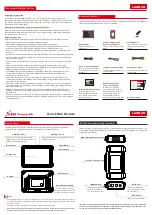
Append
ix E
Shock Advisory System
LIFEPAK 20e Defibrillator/Monitor Operating Instructions
E-3
©2006-2015 Physio-Control, Inc.
Operator Control of Shock Therapy
The Shock Advisory System causes the AED to charge automatically when it detects the
presence of a shockable rhythm. When a shock is advised, the operator presses the
SHOCK
button to deliver the energy to the patient. Analysis is disabled while the device is charging or
charged.
Continuous Patient Surveillance System
The Continuous Patient Surveillance System (CPSS) automatically monitors the patient's ECG
rhythm for a potentially shockable rhythm while the electrodes are attached and the AED is
turned on. CPSS is not active during ECG analysis or when the AED is in a CPR cycle.
Motion Detection
The Shock Advisory System detects patient motion independent of ECG analysis. Motion
detection is intended to detect periods when the ECG may be affected by substantial motion
artifact.
MOTION DETECTION
can be configured in the setup mode to be
ON
or
OFF
.
If medium-frequency variations in the transthoracic impedance signal exceed a maximum limit,
the Shock Advisory System determines that patient motion of some kind is present. If motion is
detected, the ECG analysis is delayed. The operator is advised by a displayed message, a voice
prompt, and an audible alert. After 10 seconds, if motion is still present, the motion alert stops
and the analysis always proceeds to completion. This limits the delay in therapy in situations
where it may not be possible to stop the motion. However, the rescuer should remove the source
of motion whenever possible to minimize the chance of artifact in the ECG.
Common causes of motion alerts include CPR, spontaneous patient movement, rescuers moving
the patient, and ambulance transport.
There are two reasons why ECG analysis is delayed when the motion alert occurs, and why the
rescuer should remove the source of the motion whenever possible:
1 Such motion may cause artifact in the ECG signal. This artifact can cause a nonshockable
ECG rhythm to look like a shockable rhythm. For example, chest compressions during
asystole can look like shockable ventricular tachycardia. Artifact can also cause a shockable
ECG rhythm to look like a nonshockable rhythm. For example, chest compressions during
ventricular fibrillation can look like an organized and, therefore, nonshockable rhythm.
2 The motion may be caused by a rescuer’s interventions. To reduce the risk of inadvertently
shocking a rescuer, the motion alert prompts the rescuer to move away from the patient. This
will stop the motion and ECG analysis will proceed.
The motion detection feature can be set to off. When this option is off, analysis of the ECG is
allowed to proceed uninhibited even in the presence of motion, which may or may not cause
artifact in the ECG as described previously. Artifact in the ECG can sometimes cause an
erroneous shock advisory decision.
The skill and training level of the care providers should be taken into consideration when
deciding whether or not to turn off the motion detection feature. How readily do the users
respond to the AED voice prompt? For example, do they immediately stop CPR upon hearing the
STAND CLEAR, ANALYZING NOW
prompt?
Содержание LIFEPAK 20
Страница 2: ...LIFEPAK 20e DEFIBRILLATOR MONITOR Operating Instructions ...
Страница 3: ......
Страница 4: ...LIFEPAK 20e DEFIBRILLATOR MONITOR OPERATING INSTRUCTIONS ...
Страница 15: ......
Страница 49: ......
Страница 111: ......
Страница 155: ......
Страница 171: ......
Страница 181: ......
Страница 183: ......
Страница 189: ......
Страница 191: ......
Страница 195: ......
Страница 199: ......
Страница 201: ......
Страница 205: ......
Страница 209: ......
Страница 211: ......
Страница 213: ......
Страница 215: ......
Страница 221: ......
Страница 226: ......
















































